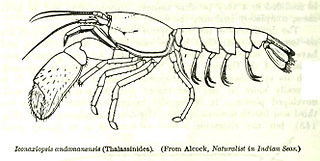
Metanephrops challengeri is a species of slim, pink lobster that lives around the coast of New Zealand. It is typically 13–18 cm (5–7 in) long and weighs around 100 g (3.5 oz). The carapace and abdomen are smooth, and adults are white with pink and brown markings and a conspicuous pair of long, slim claws. M. challengeri lives in burrows at depths of 140–640 m (460–2,100 ft) in a variety of sediments. Although individuals can live for up to 15 years, the species shows low fecundity, where small numbers of larvae hatch at an advanced stage.

Hippolytidae is a family of cleaner shrimp, also known as broken-back shrimp or anemone shrimp. The term "broken-back shrimp" also applies to the genus Hippolyte in particular and "cleaner shrimp" is sometimes applied exclusively to Lysmata amboinensis.
Charles Spence Bate, was a British zoologist and dentist.

The Hyperiidea are a suborder of amphipods, small aquatic crustaceans. Unlike the other suborders of Amphipoda, hyperiids are exclusively marine and do not occur in fresh water. Hyperiids are distinguished by their large eyes and planktonic habitat. Most species of hyperiids are parasites or predators of salps and jellyfish in the plankton, although Themisto gaudichaudii and a few relatives are free-swimming predators of copepods and other small planktonic animals.

Acanthacaris is a genus of deep-water lobsters. It contains two species, A. caeca and A. tenuimana, and is the only genus in the subfamily Neophoberinae.

Eiconaxius is a genus of mud lobster that includes the following species:

Benthesicymus is a genus of prawns, containing the following species:
Periclimenes batei is a species of shrimp found in the Pacific and Indian Oceans. It was first named by L. A. Borradaile in 1888, in commemoration of Charles Spence Bate who wrote the section on shrimp in the reports of the Challenger expedition.
Scyllarus pygmaeus is a species of slipper lobster that lives in shallow water in the Mediterranean Sea and eastern Atlantic Ocean. It grows to a length of 55 mm (2.2 in), which is too small for it to be fished for food. The juvenile form was first described in 1885, with the description of the adult following in 1888 as a result of the Challenger expedition.

Campylonotoidea is a superfamily of shrimp, containing the two families Campylonotidae and Bathypalaemonellidae. Fenner A. Chace considered it to be the sister group to the much larger superfamily Palaemonoidea, with which it shares the absence of endopods on the pereiopods, and the fact that the first pereiopod is thinner than the second. Using molecular phylogenetics, Bracken et al. proposed that Campylonotoidea may be closer to Atyoidea. There are sixteen described species in 3 genera; no fossils are known.

Marsupenaeus is a monotypic genus of prawn. It contains a single species, Marsupenaeus japonicus, known as the kuruma shrimp, kuruma prawn, or Japanese tiger prawn. It occurs naturally in bays and seas of the Indo-West Pacific, but has also reached the Mediterranean Sea as a Lessepsian migrant. It is one of the largest species of prawns, and is accordingly one of the most economically important species in the family.

Ibacus alticrenatus is a species of slipper lobster that lives in the waters of Australia and New Zealand.
Leptochela is a genus of small shrimp from the family Pasiphaeidae. They are found in the Indo-Pacific region and the western Atlantic with an isolated species in Hawaii, they are absent from the eastern Atlantic Ocean and were absent from the eastern Pacific but specimens of a species widespread in the western Atlantic were collected from waters to the south of the tip of Baja California. Two species, Leptochela aculeocaudata and Leptochela pugnax have invaded the eastern Mediterranean from the Red Sea through the Suez Canal and are thus classified as Lessepsian migrants.

Solenoceridae is a family of decapods, containing 10 genera. Members of this family are marine, inhabiting shallow and offshore waters from the mid-continental shelf, ranging from depths to 1000 meters deep. Members of this family are also sometimes confused with other commercial shrimp species.

Hymenopenaeus is a genus of prawns containing 17 species.

Acanthephyra is a genus of shrimp in the family Acanthephyridae, with species that live at depths from 0 to more than 5000 meters deep below the ocean surface.
Apherusa is a genus of amphipods belonging to the family Calliopiidae.
Atyoida serrata is a species of freshwater shrimp of the family Atyidae and genus Atyoida. The species lives in the Vungu, Umgeni, and Mtamvuna rivers in South Africa, as well as the Langevin River on Réunion Island.

Pandalus lucidirimicola, the sparkling shrimp, is a species of caridean shrimp in the family Pandalidae.











